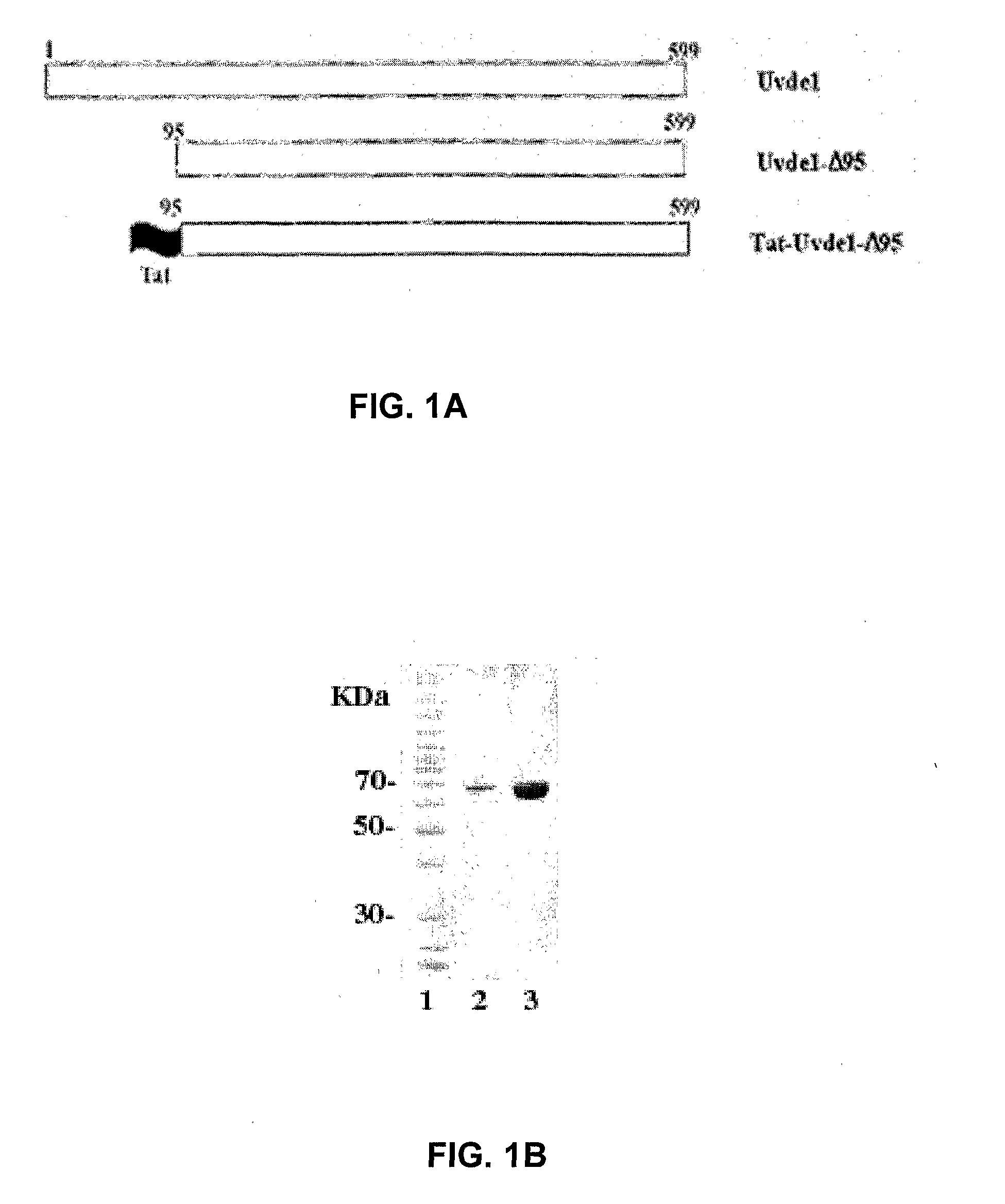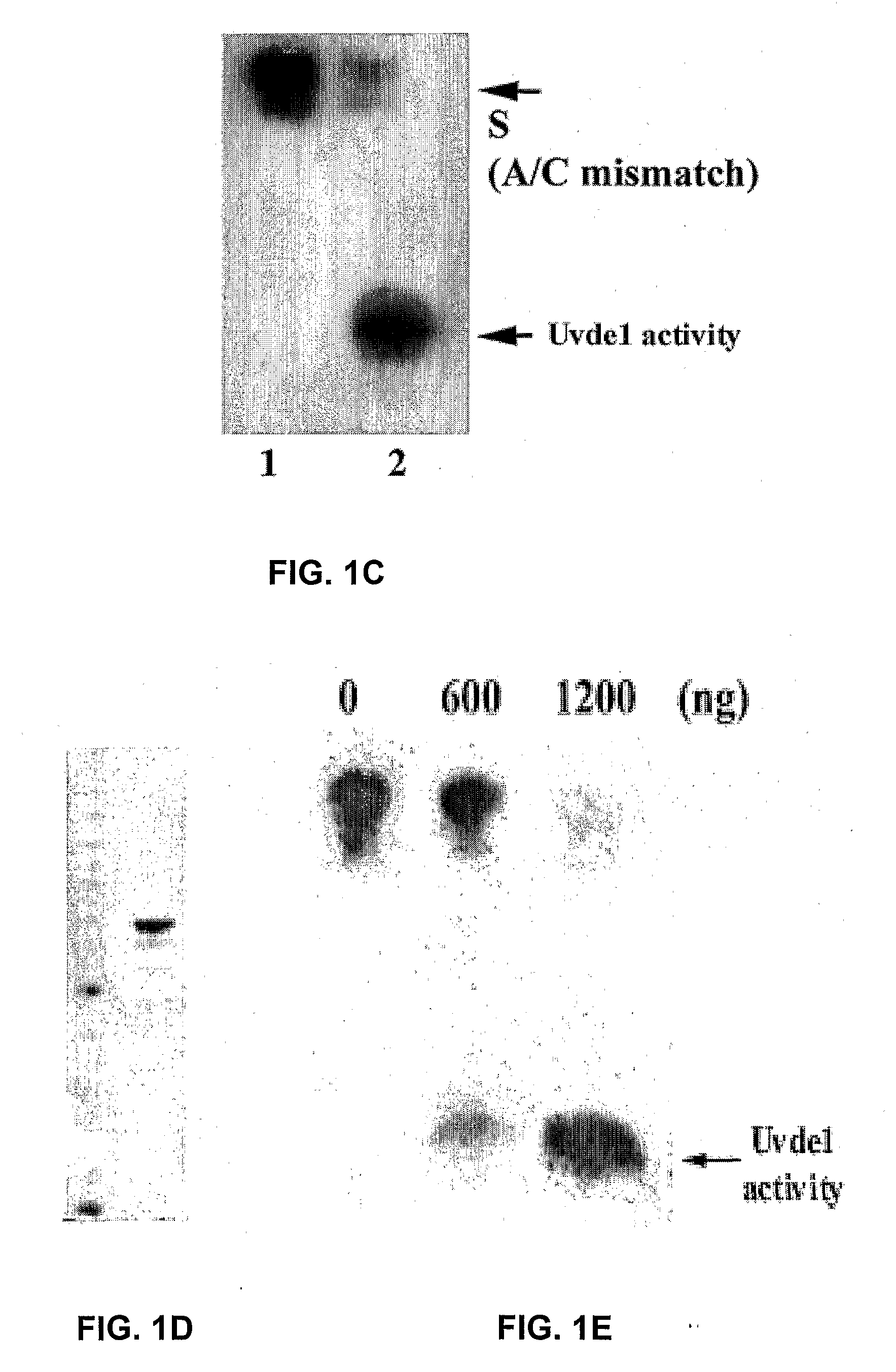[0026]An additional aspect of the present invention is methods for reducing aging of
skin due to
exposure to UV, for example, due to tanning and / or
sunburn, or due to
exposure of to a mutagenic compound such as
a DNA intercalating agent,
a DNA methylating agent, including
occupational exposure. The methods encompass the step of applying a composition comprising as the
active ingredient an amount of the re-engineered Uvde1 of the present invention together with a
cell penetration peptide (either as a separate molecule or as part of a
fusion protein construct), and a carrier acceptable and useful for topical application of a protein. The Uvde1-Δ95 protein, together with a cell penetration peptide, can be incorporated in a
lotion, potion, cream, ointment or other formulation suitable for topical administration, or it can be incorporated in a pharmaceutical composition suitable for parenteral administration, for example, intravenous administration.
[0031]In yet another aspect, the invention relates to a
nucleic acid vector comprising a
nucleotide sequence encoding Uvde1-Δ95, Tat-Uvde1-Δ95 or Tat-Uvde1-Δ95-His-tag and transcription and translation control sequences effective to initiate transcription and subsequent protein synthesis in a host cell. Where a His-tagged Uvde1 derivative is expressed, the His tag portion is desirably removed (after affinity purification) by
protease cleavage, for example using
thrombin, but the presence of the His tag does not negatively
impact activity, cell penetration (in the case of Tat or other cell penetration peptide fusion proteins) or stability during storage.
[0032]The present invention further provides methods for cleaving DNA molecules at positions with structural distortions, wherein the DNA is cleaved in the vicinity of the distortion by a stable truncated Uvde1 protein of the present invention. The structural distortion can result from mismatch at the site of the distortion in a double-stranded DNA molecule, from UV damage or from other damage to DNA due to
chemical reaction, for example, with an alkylating or depurination agent or due to damage due to UV
irradiation,
ionizing radiation or other
irradiation damage. Abasic sites, mismatch, intercalated molecules such as
ethidium bromide, and adducts formed by
cisplatin compounds also cause distortion of double-stranded DNA and may result in or be the result of mutations; these structural aberrations can also trigger cleavage and repair via the Uvde1 derivative of the present invention. Cumulative damage to DNA can result in an unattractive and aged appearance of the skin, especially on the face, neck and chest, if that damage is not repaired, The stable truncated Uvde1 proteins can be supplied to the skin in substantially pure form for
in vitro reactions, or they can be supplied for
in vivo reactions, including but not limited to compositions for topical application (in the form or of an ointment,
salve, cream,
lotion, liquid or
transdermal patch) in compositions for topical administration, with the result that damage to skin cells is reduced and the apparent aging of the skin is reduced. The Uvde1 derivatives of the present invention can also be used to treat potential systemic
DNA damage via internal use (to be administered by intraperitoneal, intradermal, subcutaneous, intravenous or
intramuscular injection), for example, after exposure to a mutagenic compound to which a person has been exposed, with the result that systemic damage resulting from distorted DNA structure and
mutagenesis is reduced. The stable truncated Uvde1 derivatives of the present invention repair a wide variety of mismatch and
DNA damage. The cleavage of a
double stranded DNA molecule having structural distortion due to
nucleotide mispairing (mismatch) or due to
DNA damage by a stable truncated Uvde1 derivative of the present invention can be used to
advantage in a relatively simple
assay for structural distortion wherein cleavage of a test molecule (i.e., the
double stranded DNA molecule which is being screened for damage, mismatch or other structural distortion) is to be detected.
 Login to View More
Login to View More 


